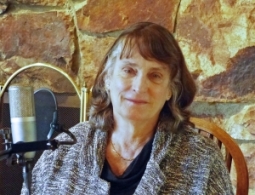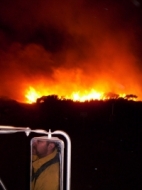

Hear our KNSJ radio interview with Diane Conklin, Mussey Grade Road Alliance, by clicking the audio link. Conklin estimates cost of SDG&E’s proposal could be $280 per household.
By Miriam Raftery
January 6, 2017 (San Diego’s East County) --In 2012, a huge turnout by ratepayers helped persuade the California Public Utilities Commission to deny SDG&E’s request to charge ratepayers for its uninsured costs of three 2007 wildfires.
Now the utility has revived a similar proposal, seeking $379 million from ratepayers. On Monday, the CPUC will hold public hearings in Escondido at 2 p.m. and 7 p.m. at the California Center for the Arts Escondido conference center, Salon 1Room, 340 North Escondido Blvd. in Escondido.
Advocates for ratepayers and fire survivors are urging the public to again turn out in force at Monday’s hearings, arguing that it would be unfair and set a bad precedent to allow a utility to charge ratepayers for fires caused by its equipment. They say that SDG&E should have foreseen high winds and taken steps to protect the public. The group estimates average cost per household would be $280 if SDG&E’s proposal is approved.
But SDG&E contends that it’s fair to ask ratepayers to help shoulder costs of the fires, which it contends were natural disasters with winds stronger than seen in previous fires. The company also notes that it has worked to reduce claims and made major investments to improve fire safety for the future.
“If SDG&E gets $379 million from ratepayers for fires ignited by their equipment, then the doors wil be open for SDG&E asking for another round of money for the next fires that occur,” says Diane Conklin with the Mussey Grade Road Alliance in Ramona, a watchdog group that advocates on behalf of ratepayers and fire survivors in wildfire-related issues. “Ten years after the fires, SDG&E is really hoping the public doesn’t turn out on Monday.”
The group estimates the average cost per household could be around $280. Conklin adds, “We fought for these hearings so that you can tell them [the CPUC commissioner and administrative law judge coming to Escondido) why you don’t want to pay for these fires.”
There were over a dozen wildfires in 2007 across our region. Cal-Fire concluded that SDG&E equipment caused the Witch and Rice fires, and share responsibility with Cox for the Guejito Fire. The fires burned over 200,000 acres, destroyed around 1,300 homes and caused two deaths.
Hanan Eisenman with SDG&E says the October 2007 firestorms were a natural disaster that affected everyone in our region. “They included the worst Santa Ana conditions we’ve ever seen – high heat, hurricane force winds of 90 miles per hour, and low humidity, so despite maintaining safe systems, our systems were involved in three fires.”
Conklin contends that evidence found by their expert and presented in their testimony suggests otherwise. (See pp. 54 - 91 for excerpts from the 1981 and 2007 SDG&E wind studies.) “Our expert found out that SDG&E weather analyses going back to 1981 shows SDG&E knew they could regularly expect winds gusting more than 56 miles per hour, and that’s the standard to which SDG&E has built.”
A Forest Service report on the 2003 firestorms, four years before the 2007 wildfires in San Diego County, confirmed that gusts up to 70 miles an hour were recorded in the Paradise Fire.
Eisenman says SDG&E received $5.6 billion in claims initially. “We’ve worked hard to resolve all those claims and reduce impacts to customers with settlements and insurance,” he points out. “We’ve brought that $5.6 billion down to $375 million, and that’s what we’re asking recovery for…This would settle all the remaining claims from the fires.”
Opponents of the proposal to charge ratepayers contend that shareholders of Sempra Energy, SDG&E’s parent corporation, should shoulder those costs since SDG&E was not insured at a high enough level to cover its losses from the fires.
But Eisenman contends the company and its shareholders have invested in significant fire safety improvements to prevent a future catastrophe. “Public safety is our priority,” he insists. Since the fires, SDG&E has replaced 7,000 wood poles with durable steel poles. Each year, the company brings in a massive air crane helicopter to knock down fires before they can grow out of control. “It fought several fires this year,” Eisenman says of the helicopter.
SDG&E also added 170 weather stations. “We brought in the largest utility-owned weather predicting system in the nation,” Eisenman says. These enable the company to preposition firefighting resources. SDG&E also has fire coordinators and meteorologists on staff. In addition, the company helped upgrade communications equipment for 60 fire stations.
Conklin says she “applauds” SDG&E’s efforts to improve fire safety since 2007. But she contends, “If SDG&E gets $379 million for fires ignited by their equipment, then the doors will be open for SDG&E asking for another round of money for the next fires that will occur. We are very concerned that this will cause a moral hazard problem. It will mean that SDG&E will be less, not more prudent.”
She also voiced concerns that other utilities could be emboldened to cut corners on public safety to protect against disasters such as the San Bruno pipeline explosion involved PG&E equipment. She suggested that Southern California Gas, a Sempra company, could seek reimbursement from ratepayers across Southern California for its costs related to the massive methane gas leak that forced evacuations for months in the Porter Ranch community near Los Angeles.
Supervisor Dianne Jacob has also weighed in against the proposal, in a letter to the CPUC chair that her staffer will read at Monday's hearing. She calls the proposal "beyond preposterous" adding that is is "especially outrageous to those victims who lost their homes and even loved ones and are now being asked to help pay for the utility company's mistakes." She noted that San Diego's ratepayers have also been "on the hook for the more than $3.3 billion settlement agreement relating to the closure of the San Onore Nuclear Generating Station (SONGS) c which was caused by faulty generators."
Eisenman disagrees. “We operated our system appropriately, which is why we believe it’s reasonable that we be permitted to recover those remaining costs,” he says. “Our hearts go out to everyone affected by the fires, “ he adds, noting that some of SDG&E’s own employees were evacuated. “Going forward, we’re going to be focused on safety.”
But Conklin concludes, “If we pay the monopoly utility for their mistakes in the sense that their equipment ignited these fires, then we’re teaching the market not just here, but throughout the state and then throughout the country that monopoly utilities, where there are no municipal utilities, can stick it to the ratepayers. If it can happen in California, it can happen in other places too—and we don’t want that.”










Comments
2007 fires
Just Say No to SDG&E
Their proposal will set a bad precedent (or is it president?) by forcing ratepayers to be billed for the company's management and safety lapses or failures.
My son's home was saved but many in the area were burned, Larry Himmell reported on the Cedar fire as his home was destroyed behind him!
Are there any readers who can help with transportation to Escondido?